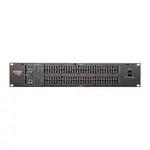This is a slightly more expensive route than trying to notch out the frequencies that are causing the feedback, but is quite effective... pick up some hypercardiod mics. This won't solve all your problems, but helped me with some major PA issues this last month. I am putting on a show (this weekend, actually!) in a rectangular firehall with a stage set into the center of one of the long walls, and the PA cabs are facing away from us (which is the first step to removing feedback, but you don't have that option), and since I am recording it, I am using condensers for the vocals. This obviously creates a major feedback issue, but I much prefer the sound of condensers to dynamics in a recording setting, so standards be damned! I picked up two Rode NT3s on ebay for half price, and they work wonders. You have to be singing right into the front of those things, right up close for them to grab any sort of sound. Not the best for studio recording, solely because of how close you have to get to them, but for live recording, they are great, and they eliminate most of my feedback issues... I plugged one in, ran up in front of one of
my 1x15" cabs, and from two feet away it wasnt feeding back, and the sound was filling the room. Just my humble suggestion, but this may be the way to go (bare in mind, however, that with condensers comes the need fort phantom power - you might want to poke around for some hypercard dynamics, if they make such a thing... time for some research, cus now Im curious!)
Another thing you could try for practice purposes is getting a headphone amp, attaching it to the output of the board (send a separate mix through aux outs if you have em, or just run the main outs to the thing), and give people earbuds or headphones for practices. I know headphones are rather a cumbersome annoyance when you are just playin live, but this may be another viable option in such a tight space.


 . If you have to crank your amp to hear it because it's shooting at your knees or you stand right next to the cymbals, you should change that. Tilting an amp so it shoots at your ears makes a lot of difference.
. If you have to crank your amp to hear it because it's shooting at your knees or you stand right next to the cymbals, you should change that. Tilting an amp so it shoots at your ears makes a lot of difference.